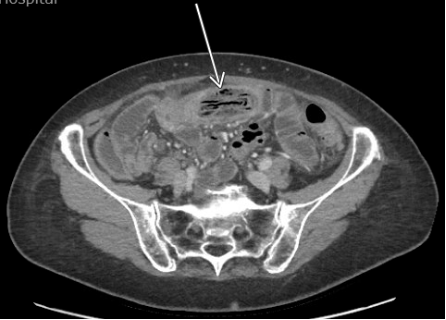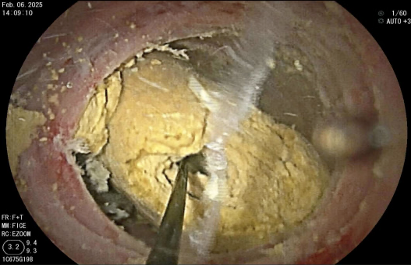Sunday Poster Session
Category: Small Intestine
P1961 - Electrohydraulic Lithotripsy for the Treatment of Impacted Ileal Bezoar
Sunday, October 26, 2025
3:30 PM - 7:00 PM PDT
Location: Exhibit Hall

Nikki Arceneaux, MD (she/her/hers)
Louisiana State University Health Sciences Center New Orleans
New Orleans, LA
Presenting Author(s)
Nikki Arceneaux, MD1, Munraj Singh, MD2, Daniel Raines, MD, FACG2
1Louisiana State University Health Sciences Center New Orleans, New Orleans, LA; 2Louisiana State University, New Orleans, LA
Introduction: Bezoars are masses composed of undigested food, medications, and hair found in the gastrointestinal tract. Bezoars that form primarily in the small intestine usually occur when a mechanical factor alters motility, such as a diverticulum, stricture, or tumor. Treatment options include solvent medications, endoscopic removal and surgery. If untreated, impacted bezoars can lead to complications such as bowel obstruction or impaction. We present a case of an impacted proximal ileum bezoar treated with electrohydraulic (EHL) lithotripsy.
Case Description/
Methods: A 76-year-old woman with a PMH of GERD presented to GI clinic for 2 months of postprandial abdominal pain, decreased oral intake and 15-pound weight loss. Her abdominal exam revealed no tenderness to palpation. Laboratory evaluation revealed a white blood cell count of 8.57 K/uL, hemoglobin of 14.8 g/dL, and a lipase of 43 U/L. Computed tomagraphy (CT) scan revealed fluid-filled dilated loops of small bowel and bezoar type filling defect within a loop of distal small bowel. Upper double balloon enteroscopy revealed multiple calcified accumulations of food residue found proximal to a benign appearing area of stenosis within the proximal ileum. Attempts were made to remove the bezoar with a snare, roth net, and graspers, but were unsuccessful due to the size and hardness. Next, an electrohydraulic lithotripter probe was used to mechanically fragment the stones into smaller pieces. Ultimately, the patient was referred to surgery for definitive management of small bowel stricture.
Discussion: There are four main types of bezoars based on digested material: phytobezoars, trichobezoars, pharmacobezoars, and lactobezoars. Phytobezoars, the most common type, are composed of vegetable matter, containing non-digestible fibers. While most patients remain asymptomatic, some may present with abdominal discomfort, weight loss and bowel obstruction. Diagnosis can be made by CT imaging findings, which show a mottled gas pattern within the bezoar. Nonoperative approaches such as dietary therapy, enzymatic dissolution and endoscopic removal techniques are regarded as the mainstays of treatment. Endoscopic techniques include mechanical disruption and extraction with instruments such as polypectomy snares, tripod forceps, and water jet devices. If these modalities are ineffective, EHL has been discussed as a possible alternative therapy. While most bezoars can be managed endoscopically, some may necessitate surgical intervention for successful resolution.

Figure: Figure 1: CT enterography with contrast demonstrating dilated intestinal loops and a mass with a mottled gas pattern suggestive of a bezoar

Figure: Figure 2: EHL lithotripsy treatment of proximal ileum bezoar
Disclosures:
Nikki Arceneaux indicated no relevant financial relationships.
Munraj Singh indicated no relevant financial relationships.
Daniel Raines indicated no relevant financial relationships.
Nikki Arceneaux, MD1, Munraj Singh, MD2, Daniel Raines, MD, FACG2. P1961 - Electrohydraulic Lithotripsy for the Treatment of Impacted Ileal Bezoar, ACG 2025 Annual Scientific Meeting Abstracts. Phoenix, AZ: American College of Gastroenterology.
1Louisiana State University Health Sciences Center New Orleans, New Orleans, LA; 2Louisiana State University, New Orleans, LA
Introduction: Bezoars are masses composed of undigested food, medications, and hair found in the gastrointestinal tract. Bezoars that form primarily in the small intestine usually occur when a mechanical factor alters motility, such as a diverticulum, stricture, or tumor. Treatment options include solvent medications, endoscopic removal and surgery. If untreated, impacted bezoars can lead to complications such as bowel obstruction or impaction. We present a case of an impacted proximal ileum bezoar treated with electrohydraulic (EHL) lithotripsy.
Case Description/
Methods: A 76-year-old woman with a PMH of GERD presented to GI clinic for 2 months of postprandial abdominal pain, decreased oral intake and 15-pound weight loss. Her abdominal exam revealed no tenderness to palpation. Laboratory evaluation revealed a white blood cell count of 8.57 K/uL, hemoglobin of 14.8 g/dL, and a lipase of 43 U/L. Computed tomagraphy (CT) scan revealed fluid-filled dilated loops of small bowel and bezoar type filling defect within a loop of distal small bowel. Upper double balloon enteroscopy revealed multiple calcified accumulations of food residue found proximal to a benign appearing area of stenosis within the proximal ileum. Attempts were made to remove the bezoar with a snare, roth net, and graspers, but were unsuccessful due to the size and hardness. Next, an electrohydraulic lithotripter probe was used to mechanically fragment the stones into smaller pieces. Ultimately, the patient was referred to surgery for definitive management of small bowel stricture.
Discussion: There are four main types of bezoars based on digested material: phytobezoars, trichobezoars, pharmacobezoars, and lactobezoars. Phytobezoars, the most common type, are composed of vegetable matter, containing non-digestible fibers. While most patients remain asymptomatic, some may present with abdominal discomfort, weight loss and bowel obstruction. Diagnosis can be made by CT imaging findings, which show a mottled gas pattern within the bezoar. Nonoperative approaches such as dietary therapy, enzymatic dissolution and endoscopic removal techniques are regarded as the mainstays of treatment. Endoscopic techniques include mechanical disruption and extraction with instruments such as polypectomy snares, tripod forceps, and water jet devices. If these modalities are ineffective, EHL has been discussed as a possible alternative therapy. While most bezoars can be managed endoscopically, some may necessitate surgical intervention for successful resolution.

Figure: Figure 1: CT enterography with contrast demonstrating dilated intestinal loops and a mass with a mottled gas pattern suggestive of a bezoar

Figure: Figure 2: EHL lithotripsy treatment of proximal ileum bezoar
Disclosures:
Nikki Arceneaux indicated no relevant financial relationships.
Munraj Singh indicated no relevant financial relationships.
Daniel Raines indicated no relevant financial relationships.
Nikki Arceneaux, MD1, Munraj Singh, MD2, Daniel Raines, MD, FACG2. P1961 - Electrohydraulic Lithotripsy for the Treatment of Impacted Ileal Bezoar, ACG 2025 Annual Scientific Meeting Abstracts. Phoenix, AZ: American College of Gastroenterology.
